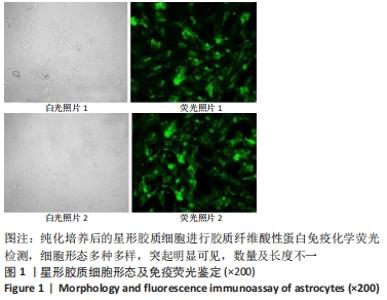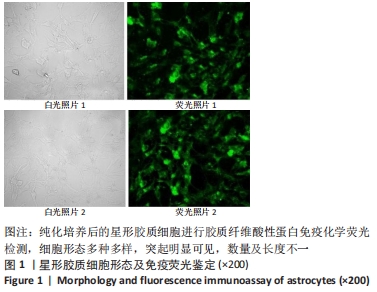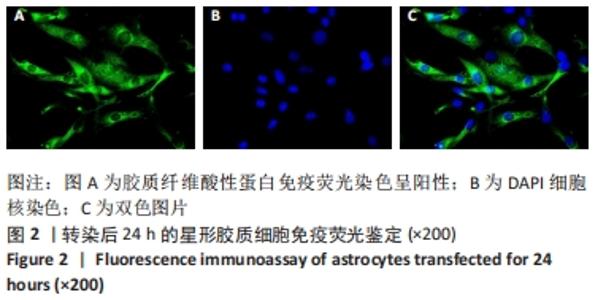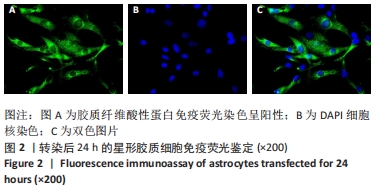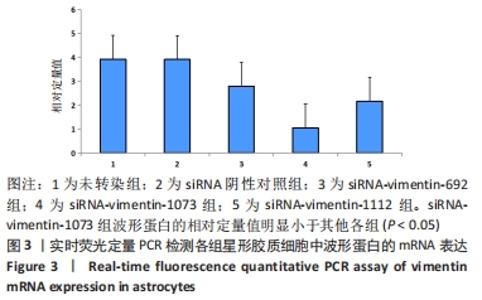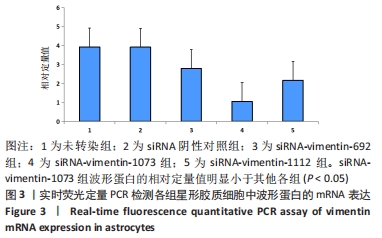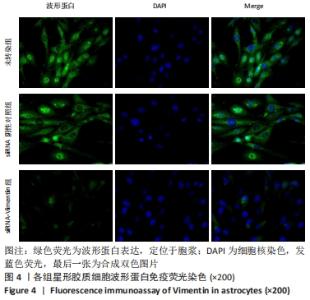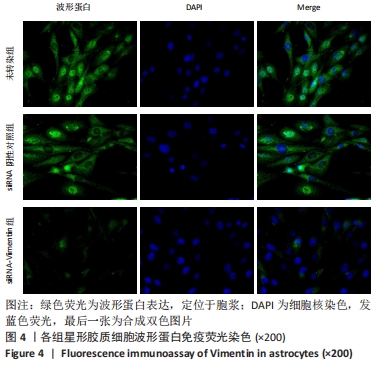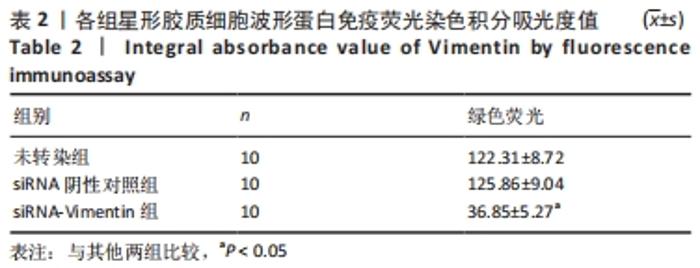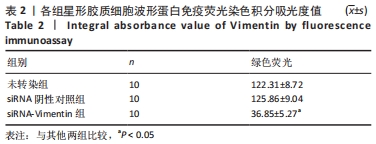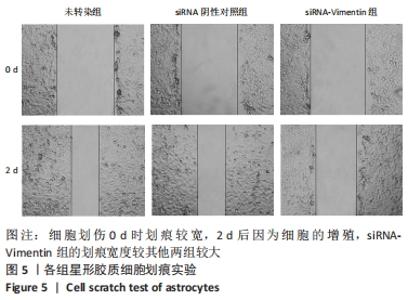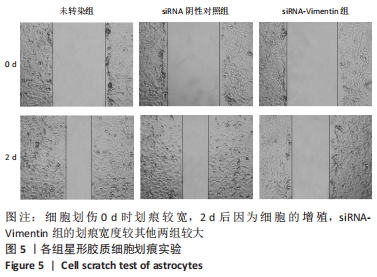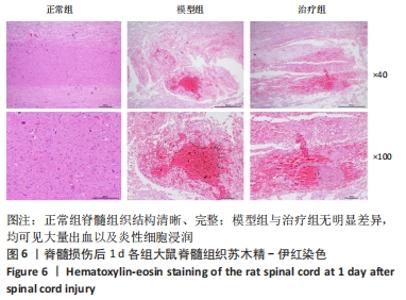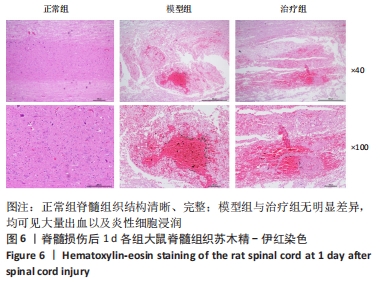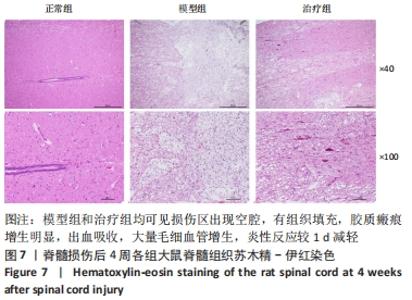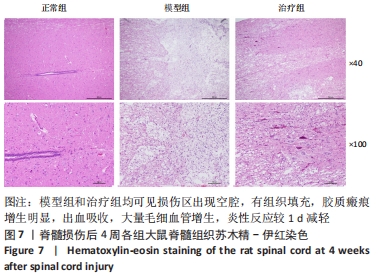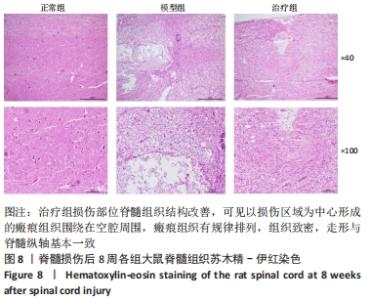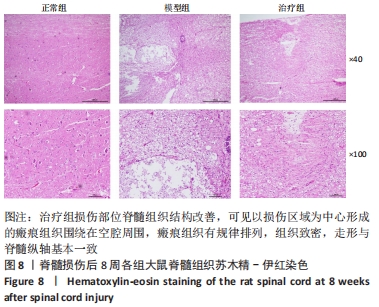Chinese Journal of Tissue Engineering Research ›› 2022, Vol. 26 ›› Issue (20): 3190-3195.doi: 10.12307/2022.619
Previous Articles Next Articles
Vimentin silenced by small interfering RNA inhibits glial scar formation in a rat model of acute spinal cord injury
Li Jianfeng1, Zhang Shulian2, Yan Jinyu2, Li jiayi1, Jin Zhao1, Deng Qi2
- 1Second Rehabilitation Hospital of Beijing, Beijing 100038, China; 2Rehabilitation Department, the Second Affiliated Hospital of Inner Mongolia Medical University, Hohhot 010030, Inner Mongolia Autonomous Region, China
-
Received:2021-09-08Accepted:2021-11-04Online:2022-07-18Published:2022-01-20 -
Contact:Deng Qi, Associate chief physician, Rehabilitation Department, the Second Affiliated Hospital of Inner Mongolia Medical University, Hohhot 010030, Inner Mongolia Autonomous Region, China -
About author:Li Jianfeng, MD, Associate chief physician, Second Rehabilitation Hospital of Beijing, Beijing 100038, China -
Supported by:the National Natural Science Foundation of China, No. 81560212 (to LJF); the Natural Science Foundation of Inner Mongolia Autonomous Region, No. 2015MS0898 (to LJF)
CLC Number:
Cite this article
Li Jianfeng, Zhang Shulian, Yan Jinyu, Li jiayi, Jin Zhao, Deng Qi. Vimentin silenced by small interfering RNA inhibits glial scar formation in a rat model of acute spinal cord injury[J]. Chinese Journal of Tissue Engineering Research, 2022, 26(20): 3190-3195.
share this article
Add to citation manager EndNote|Reference Manager|ProCite|BibTeX|RefWorks
| [1] KHORASANIZADEH M, YOUSEFIFARD M, ESKIAN M, et al. Neurological recovery following traumatic spinal cord injury: a systematic review and meta-analysis. J Neurosurg Spine. 2019;30:683-699. [2] FAULKNER JR, HERRMANN JE, WOO MJ, et al. Reactive astrocytes protect tissue and preserve function after spinal cord injury. J Neurosci. 2004;24(9):2143-2155. [3] SULLIVAN PZ, ALBAYAR A, BURRELL JC, et al. Implantation of Engineered Axon Tracts to Bridge Spinal Cord Injury Beyond the Glial Scar in Rats. Tissue Eng Part A. 2021;27(19-20):1264-1274. [4] BANG M, RYU O, KIM DG, et al. Tenovin-1 Induces Senescence and Decreases Wound-Healing Activity in Cultured Rat Primary Astrocytes. Biomol Ther (Seoul). 2019;27(3):283-289. [5] TAN X, CHEN C, ZHU Y, et al. Proteotoxic Stress Desensitizes TGF-beta Signaling Through Receptor Downregulation in Retinal Pigment Epithelial Cells. Curr Mol Med. 2017;17(3):189-199. [6] WILSON S, FREDERICKS DC, SAFAYI S, et al. Ovine Hemisection Model of Spinal Cord Injury. J Invest Surg. 2021;34(4):380-392. [7] ALIZADEH A, DYCK SM, KARIMI-ABDOLREZAEE S. Traumatic Spinal Cord Injury: An Overview of Pathophysiology, Models and Acute Injury Mechanisms. Front Neurol. 2019;10:282. [8] AHUJA CS, MOTHE A, KHAZAEI M, et al. The leading edge: Emerging neuroprotective and neuroregenerative cell-based therapies for spinal cord injury. Stem Cells Transl Med. 2020;9(12):1509-1530. [9] LI X, LI M, TIAN L, et al. Reactive Astrogliosis: Implications in Spinal Cord Injury Progression and Therapy. Oxid Med Cell Longev. 2020; 2020:9494352. [10] KIM YH, HA KY, KIM SI. Spinal Cord Injury and Related Clinical Trials. Clin Orthop Surg. 2017;9(1):1-9. [11] ZHENG Y, MAO YR, YUAN TF, et al. Multimodal treatment for spinal cord injury: a sword of neuroregeneration upon neuromodulation. Neural Regen Res. 2020;15(8):1437-1450. [12] YILMAZ T, KAPTANOĞLU E. Current and future medical therapeutic strategies for the functional repair of spinal cord injury. World J Orthop. 2015;6(1):42-55. [13] WILSON JR, TETREAULT LA, KWON BK, et al. Timing of Decompression in Patients With Acute Spinal Cord Injury: A Systematic Review. Global Spine J. 2017;7(3 Suppl):95S-115S. [14] CEKANAVICIUTE E, BUCKWALTER MS. Astrocytes: Integrative Regulators of Neuroinflammation in Stroke and Other Neurological Diseases. Neurotherapeutics. 2016;13(4):685-701. [15] TRAN AP, WARREN PM, SILVER J. The Biology of Regeneration Failure and Success After Spinal Cord Injury. Physiol Rev. 2018;98(2):881-917. [16] DYCK S, KATARIA H, ALIZADEH A, et al. Perturbing chondroitin sulfate proteoglycan signaling through LAR and PTPσ receptors promotes a beneficial inflammatory response following spinal cord injury. J Neuroinflammation. 2018;15(1):90. [17] WANG GY, CHENG ZJ, YUAN PW, et al. Olfactory ensheathing cell transplantation alters the expression of chondroitin sulfate proteoglycans and promotes axonal regeneration after spinal cord injury. Neural Regen Res. 2021;16(8):1638-1644. [18] ANJUM A, YAZID MD, FAUZI DAUD M, et al. Spinal Cord Injury: Pathophysiology, Multimolecular Interactions, and Underlying Recovery Mechanisms. Int J Mol Sci. 2020;21(20):7533. [19] ORR MB, GENSEL JC. Spinal Cord Injury Scarring and Inflammation: Therapies Targeting Glial and Inflammatory Responses. Neurotherapeutics. 2018;15(3):541-553. [20] WILLIAMS A, PIATON G, LUBETZKI C. Astrocytes--friends or foes in multiple sclerosis? Glia. 2007;55(13):1300-1312. [21] LENT R, AZEVEDO FA, ANDRADE-MORAES CH, et al. How many neurons do you have? Some dogmas of quantitative neuroscience under revision. Eur J Neurosci. 2012;35(1):1-9. [22] LOSHAJ-SHALA A, COLZANI M, BREZOVSKA K, et al. Immunoproteomic identification of antigenic candidate Campylobacter jejuni and human peripheral nerve proteins involved in Guillain-Barré syndrome. J Neuroimmunol. 2018;317:77-83. [23] TESHIGAWARA K, KUBOYAMA T, SHIGYO M, et al. A novel compound, denosomin, ameliorates spinal cord injury via axonal growth associated with astrocyte-secreted vimentin. Br J Pharmacol. 2013;168(4):903-919. [24] DANIELSSON F, PETERSON MK, CALDEIRA ARAÚJO H, et al. Vimentin Diversity in Health and Disease. Cells. 2018;7(10):147. [25] RAGINOV IS, CHELYSHEV IUA, SHAGIDULLIN TF. Interaction of sensory neurons and satellite cells during stimulation of the nerve regeneration. Morfologiia. 2002;122(4):37-39. [26] BAUMANN HJ, MAHAJAN G, HAM TR, et al. Softening of the chronic hemi-section spinal cord injury scar parallels dysregulation of cellular and extracellular matrix content. J Mech Behav Biomed Mater. 2020; 110:103953. [27] DERVAN AG, ROBERTS BL. Reaction of spinal cord central canal cells to cord transection and their contribution to cord regeneration. J Comp Neurol. 2003;458(3):293-306. [28] TRUJILLO-CENÓZ O, REHERMANN MI, MACIEL C, et al. The ependymal cell cytoskeleton in the normal and injured spinal cord of mice. J Neurosci Res. 2021;99(10):2592-2609. [29] POLCYN R, CAPONE M, MATZELLE D, et al. Enolase inhibition alters metabolic hormones and inflammatory factors to promote neuroprotection in spinal cord injury. Neurochem Int. 2020;139:104788. [30] IZMIRYAN A, LI Z, NOTHIAS F, et al. Inactivation of vimentin in satellite glial cells affects dorsal root ganglion intermediate filament expression and neuronal axon growth in vitro. Mol Cell Neurosci. 2021; 115:103659. [31] HOFSTETTER CP, SCHWARZ EJ, HESS D, et al. Marrow stromal cells form guiding strands in the injured spinal cord and promote recovery. Proc Natl Acad Sci U S A. 2002;99(4):2199-2204. [32] JIN LQ, JOHN BH, HU J, et al. Activated Erk Is an Early Retrograde Signal After Spinal Cord Injury in the Lamprey. Front Neurosci. 2020; 14:580692. |
| [1] | Kan Houming, Fan Lijun, Chen Xuetai, Shen Wen. Application of platelet-rich plasma in neuropathic pain [J]. Chinese Journal of Tissue Engineering Research, 2022, 26(8): 1286-1292. |
| [2] | Fan Yiming, Liu Fangyu, Zhang Hongyu, Li Shuai, Wang Yansong. Serial questions about endogenous neural stem cell response in the ependymal zone after spinal cord injury [J]. Chinese Journal of Tissue Engineering Research, 2022, 26(7): 1137-1142. |
| [3] | Hu Wei, Xie Xingqi, Tu Guanjun. Exosomes derived from bone marrow mesenchymal stem cells improve the integrity of the blood-spinal cord barrier after spinal cord injury [J]. Chinese Journal of Tissue Engineering Research, 2022, 26(7): 992-998. |
| [4] | Liu Ming, Wang Kai. Chitosan/alginate composite scaffold combined with hawthorn leaf flavonoids for spinal cord injury repair [J]. Chinese Journal of Tissue Engineering Research, 2022, 26(28): 4466-4471. |
| [5] | Liu Kang, Wang Yongping, Zuo Kebin, Yang Haitao, Jia Bin. Polydatin loaded collagen/heparin sulfate scaffold in the treatment of spinal cord injury in rats [J]. Chinese Journal of Tissue Engineering Research, 2022, 26(28): 4500-4506. |
| [6] | Tang Fuyu, Zhou Binbin, Wei Weibing, Zhang Hongsheng. Effect of electroacupuncture on glial fibrillary acidic protein expression at the injured site in a rat model of spinal cord injury [J]. Chinese Journal of Tissue Engineering Research, 2022, 26(26): 4113-4117. |
| [7] | Shi Yao, Han Shufeng, Yuan Yitong, Du Ruochen, Jing Zhijie, Zhao Bichun, Zhang Ruxin, Zhang Yujuan, Wang Chunfang. Efficacy and safety of human umbilical cord mesenchymal stem cells in the treatment of spinal cord injury: a meta-analysis [J]. Chinese Journal of Tissue Engineering Research, 2022, 26(25): 4093-4100. |
| [8] | Zhang Rong, Liang Zhenting, Yang Chun, Liu Dongdong, Xi Yin, Zhang Jie, Wang Ya, Xu Yonghao, Liu Xiaoqing, Li Yimin. Effects of mechanical stretch on fiber proliferation in human lung epithelial cells [J]. Chinese Journal of Tissue Engineering Research, 2022, 26(24): 3821-3825. |
| [9] | Li Jinglu, Wang Sainan, Wang Yangyang, Fu Guiqiang, Wang Ying, Hu Jianguo, Tang Jie, Lyu Hezuo. CRID3, a blocker of apoptosis-associated speck-like protein containing a card, influences local gene transcription in mice with acute spinal cord injury: a transcriptomic analysis [J]. Chinese Journal of Tissue Engineering Research, 2022, 26(23): 3620-3632. |
| [10] | Chen Pingbo, Wang Jing, Sun Yong, Xu Xiaofeng, Chen Qian, Zhang Zhijian. Genipin crosslinked sonic hedgehog composite fibrin scaffolds for the repair of spinal cord injury in rats [J]. Chinese Journal of Tissue Engineering Research, 2022, 26(21): 3345-3350. |
| [11] | Li Chuanhong, Yu Xing, Yang Yongdong, Zhao He. Microglia in spinal cord injury: M1/M2 phenotypic polarization and neurotoxic/neuroprotective effects [J]. Chinese Journal of Tissue Engineering Research, 2022, 26(14): 2265-2272. |
| [12] | Li Shuai, Fan Yiming, Liu Fangyu, Zhang Hongyu, Wang Yansong. Effect and mechanism of astrocytes in spinal cord injury [J]. Chinese Journal of Tissue Engineering Research, 2022, 26(13): 2062-2068. |
| [13] | Sun Jianwei, Yang Xinming, An Xiaogang. Effects of various methods on improving bone marrow mesenchymal stem cell transplantation for spinal cord injury [J]. Chinese Journal of Tissue Engineering Research, 2022, 26(13): 2075-2080. |
| [14] | Duan Zhaoyuan, Wu Mingli, Luo Meng, Gao Jing, Li Ruiqing, Feng Xiaodong. Glutathione peroxidase 4 regulates neuronal ferroptosis after spinal cord injury [J]. Chinese Journal of Tissue Engineering Research, 2022, 26(12): 1956-1962. |
| [15] | Jiang Shengyuan, Deng Bowen, Xu Lin, Liu Gang, He Feng, Zhao Yi, Ren Jingpei, Mu Xiaohong. Role and mechanism of tetramethylpyrazine in spinal cord injury repair [J]. Chinese Journal of Tissue Engineering Research, 2022, 26(11): 1799-1804. |
| Viewed | ||||||
|
Full text |
|
|||||
|
Abstract |
|
|||||
